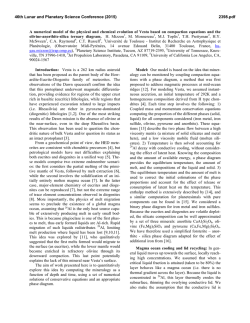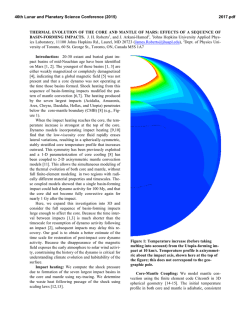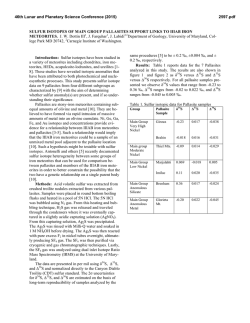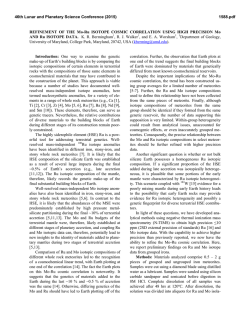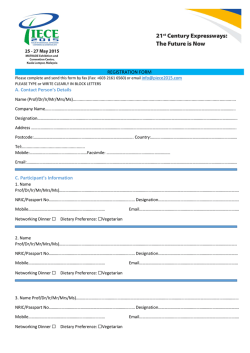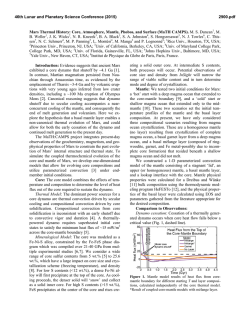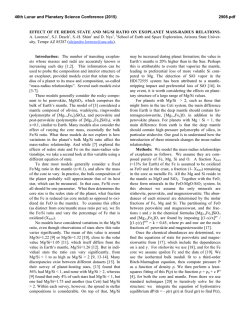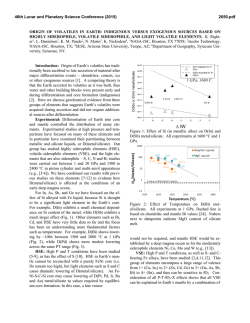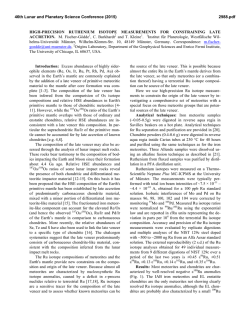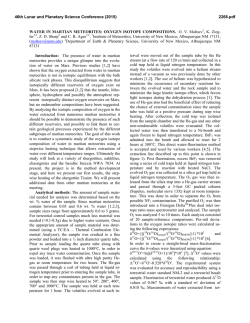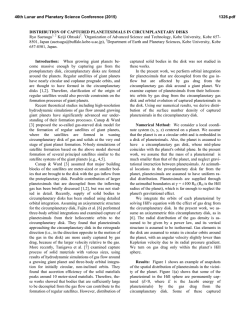
Evidence from Differentiated and Chondritic Meteorites for Hit-and
46th Lunar and Planetary Science Conference (2015) 2741.pdf EVIDENCE FROM DIFFERENTIATED AND CHONDRITIC METEORITES FOR HIT-AND-RUN IMPACTS DURING ASTEROID ACCRETION. Edward R. D. Scott1, Erik Asphaug2, Joseph I. Goldstein3, and Deon van Niekerk1. 1Hawai‘i Institute of Geophysics and Planetology, University of Hawai‘i at Manoa, Honolulu, Hawai‘i 96822, USA ([email protected]), 2School of Earth and Space Exploration, Arizona State University, Tempe, AZ 85287, USA, 3Department of Mechanical and Industrial Engineering, University of Massachusetts, Amherst, MA 01003, USA. Introduction: The conventional way to fracture differentiated asteroids, extract core samples, and generate iron meteorites is to “batter them to bits” with hypervelocity projectiles [1]. However, extracting core material from a planetesimal using conventional techniques requires an impact with a projectile having nearly half its diameter or repeated smaller impacts [2]. To destroy many large asteroids this way without destroying Vesta’s crust is very problematic [3]. Hit-and-run collisions between roughly similarsized differentiated bodies during accretion at low velocities (≤3 × their mutual escape velocity) offer an efficient way to dismember planetesimals, mix core with crust or mantle, and mix materials from different bodies while preserving Vesta’s crust [2, 4]. Planetesimals that grow into embryos maintain approximately chondritic compositions, but smaller bodies that are the debris from hit-and-run collisions of differentiated planetesimals exhibit wildly different compositions. Here we review recent numerical simulations [5] and meteorite and asteroid evidence for hit-and-run impacts during accretion and propose models to account for several types of differentiated and chondritic meteorites. Hit-and-run Collisions: Mantle stripping during planet formation. During accretion of similar-sized bodies, random relative velocities are comparable to the escape velocity of the largest bodies. But modest random velocities prevent accretion causing hit-and-run events in which the projectiles are torn asunder. During the late stage of planet formation, about half the collisions are hit-and-run impacts [2, 4, 6]. The smaller body bounces off or plows through the larger body becoming a mantle-stripped relic or a string of metal-rich bodies. Asphaug and Reufer [5] performed ~50 simulations of single hit-andrun planetary impacts with a range of impact parameters and found that the unaccreted remnants were predominantly metal-rich. Mantle material was preferentially accreted by the larger body. Statistical arguments imply that the formation of two terrestrial planets with near-chondritic compositions, Earth and Venus, from differentiated protoplanets would have created an array of smaller bodies with a wide variety of properties that experienced few-to-several hit-and-run impacts. Those that experienced few or no hit-and-run impacts have broadly chondritic compositions. At the peak of the bell-shaped distribution curve will be metal-rich bodies that experienced several hit-and-run impacts. In the long tail there will be a whole variety of metal-rich and metal-poor bodies that experienced numerous impacts. Mercury might be a metal-rich body that experienced a couple hit-and-run impacts. Dismembering Planetesimals. Impact velocities during planetesimal accretion are subsonic and do not create shocks. As in the planetary case, hit-and-run impacts effectively transfer silicate material from smaller to larger bodies. The smaller body is shredded by mechanical and gravitational interactions that segregate and disperse materials according to their density generating chains of metal-rich bodies, which predominate, as well as metal-poor bodies [2,4]. Although a comparable set of 50 simulations has not yet been performed for planetesimals, a smaller set suggests similar outcomes for planetesimal accretion but with a greater variety of impact products among the unaccreted debris. Meteorite evidence: Iron Meteorites. The IVA irons cooled through ~500°C at rates of 100-6000 °C/Myr, which are negatively correlated with bulk Ni contents. Thermal and fractional crystallization modeling indicates that the parent magma solidified inwards with Ni-poor irons on the exterior and cooled with little or no mantle material in a metallic body of radius 150±50 km [7,8]. These data and a Pb-Pb age of a IVA iron of 3 Myr after CAIs [9] point to mantle removal by hit-and-run impact before core solidification. Multiple impacts would have been needed to remove nearly all the mantle material. The IVB irons cooled at rates of 500-5000 °C/Myr, which are positively correlated with bulk Ni. The positive correlation implies that the body solidified outwards and modeling indicates that cooling occurred in a metallic body of radius 65±15 km without any significant mantle [10]. Radiometric ages are lacking for IVB irons, but efficient extraction of a core that had largely solidified favors early hit-and-run impacts during accretion. Silicate-bearing IAB iron meteorites formed during several impacts on the partly differentiated IABwinonaite parent asteroid around ~2-10 Myr after CAIs [22]. The earliest impacts were probably low-velocity hit-and-run events that mixed molten Fe-Ni and un- 46th Lunar and Planetary Science Conference (2015) shocked, winonaite-like rock fragments. Later impacts produced impact melts like Mundrabilla. Stony-iron meteorites. Diverse cooling rates of main-group pallasites and paleomagnetic properties of olivine with micrometer-sized metal-troilite intergrowths show that these pallasites did not cool at the core-mantle boundary of an asteroid [11, 12]. Residual molten metal from the core-mantle region was extracted by impact and mixed with olivine mantle fragments and early-formed pallasites with rounded olivines. This material was reaccreted onto another body, deeply buried, and cooled slowly in a magnetic field. This history is incompatible with conventional hypervelocity impacts and requires one or more subsonic impacts during accretion. The first hit-and-run impact could have removed the crust and mixed mantle fragments into the core. A second one dismembered this body, separated out the partially formed sold core, and allowed residual molten metal, mantle material, and rounded olivine pallasites to reaccrete onto the larger body. Deep burial after continued accretion of mantle fragments allowed the main group pallasites to cool slowly in the magnetic field of a core dynamo. Mesosiderites. These were formed by mixing molten core metal with crustal materials and smaller amounts of olivine mantle and deep burial of the metalsilicate mixture. Multiple hit-and-run impacts may have largely removed mantle material from a molten core. The final impact may have involved a head-on impact of a molten metallic body into the crust of a larger Vesta-like body. Alternatively, a grazing impact temporarily dispersed globs of molten core which quickly reaccreted onto the larger body and were deeply buried. Ureilite achondrites. These are coarse-grained partial melt residues that cooled rapidly from ~1100 to < 650°C in hours ~5 Myr after CAI formation [13,14]. This requires dispersal of the body in a highly energetic impact into meter-sized fragments to allow rapid cooling followed by reaccretion of cool fragments. Extensive shock requires a hypervelocity impact excluding hit-and-run impact between planetesimals. However, a protoplanetary hit-and-run impact cannot be excluded and would account for reaccretion of ureilite material. Another hit-and-run impact could have removed ureilites before protoplanets exited the asteroid belt. Chondrites. Simple models for ordinary chondrites envisage late accretion of OC parent bodies about 2 Myr after CAIs, heating by 26Al, and slow cooling over ~100 Myr to form an onion-shell structure with a core of strongly metamorphosed type 6 chondrites surrounded by successive shells of type 5-3 material [15]. Such models are incompatible with cooling rates inferred from metallography and two-pyroxene thermometry [16, 17]. They also appear inconsistent with planetary 2741.pdf accretion models, which require continued accretion of planetesimals and protoplanets into planets and do not allow planetesimals to cease interacting with other bodies for 100 Myr after they formed. Evidence for rapid cooling of OCs from two-pyroxene thermometry from >850°C to ~700 °C requires breakup and reassembly of OC bodies around ~5-10 Myr after CAI formation [17, 18]. Hit-and-run collisions during accretion offer an explanation for the disruption and reaccretion of OCs. Summary: Hit-and-run collisions can explain how numerous differentiated bodies were dismembered while preserving Vesta’s crust. They can account for the anomalous thermal histories of iron meteorite groups, impact mixing of metal and silicate to form stony-iron meteorites without extensive shock damage, slow cooling of stony irons and irons with silicate inclusions, and disruption of OC parent bodies near peak metamorphism and rapid cooling to ~700°C. Hit-and-run impacts can also explain why dunites are rare among asteroids and meteorites and why more parent bodies supplied iron meteorites than chondrites and achondrites: dense metal-rich bodies predominated among the unaccreted remnants of protoplanets and planets. Hit-and-run impacts may also have splashed silicate magma from molten planetesimals to form chondrules [19, 20]. Disruption of differentiated asteroids during accretion, rather than over billions of years [1], accounts for numerous puzzling features: the dearth of differentiated asteroid families; the odd assortments of differentiated meteorites that resemble handfuls of pieces from numerous different jig-saw puzzles that cannot be reassembled into coherent pictures; and the distribution of mostly small, orphan differentiated asteroids [21]. References: [1] Burbine T. H. et al. (1996) MAPS 31, 607. [2] Asphaug E. (2010) Chemie der Erde 70, 199. [3] Davis D. R. et al. (1985) Icarus 62, 30. [4] Asphaug E. et al. (2006) Nature 439, 155. [5] Asphaug E. and Reuffer A. (2014) Nature Geosci. 7, 564. [6] Chambers J. E. (2013) Icarus 224, 43. [7] Yang J. et al. (2007) Nature 446, 888. [8] Yang J. et al. (2008) GCA 72, 3043. [9] Blichert-Toft J. et al. (2010) EPSL 296, 469. [10] Yang J. et al. (2010) GCA 74, 4493. [11] Yang J. (2010) GCA 74, 4471. [12] Tarduno J. et al. (2012) Science 338, 939. [13] Goodrich C. et al. (2004) Chemie der Erde 64, 283. [14] Goodrich C. et al. (2010) EPSL 295, 531. [15] Trieloff M. et al. (2003) Nature 422, 502. [16] Scott E. R. D. et al. (2014) GCA 136, 13. [17] Ganguly J. et al. (2013) GCA 105, 206. [18] Van Niekerk D. et al. (2014) GCA submitted. [19] Asphaug E. (2011) EPSL 308, 369. [20] Sanders I. S. and Scott E. R. D. (2012) MAPS 47, 2170. [21] Scott E. R. D. et al. (2015) Asteroids IV (F. De Meo et al., eds) in press. [22] Schulz T. et al. (2009) EPSL 280, 185.
© Copyright 2026
